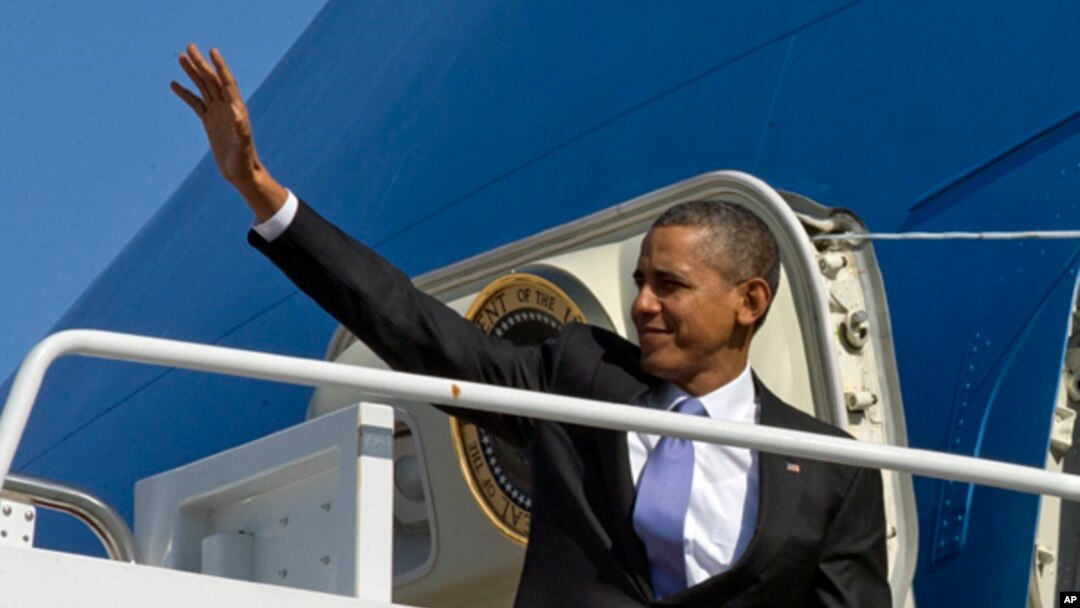LOS ANGELES —
Drought-stricken Californians are welcoming Friday's visit by President Barack Obama to their state, saying the president is drawing attention to ongoing water problems. Farmers and scientists say the water shortage is caused by unusually dry weather, and is also a question of water management.
Water expert James Famiglietti of the University of California, Irvine, says the drought is one of the worst in the state’s history.
“Whether you’re talking about snow or water storage in reservoirs or the water that’s stored in soils that we use in agriculture, they’re all at historic lows," said Famiglietti.
He says water levels are at some 20 percent of normal. The drought is felt most acutely in California’s Central Valley, a 700-kilometer stretch of fertile plain that runs north to south. The valley produces half of the nation’s fruits and vegetables and most of its nuts.
Ryan Jacobsen is a grape farmer and chief executive of the Fresno County Farm Bureau, a non-profit organization of local farmers. Fresno County is the top-producing agricultural county in the United States, and is a key stop on the president’s visit.
“We grow everything - from processing tomatoes to garlic to wine, raisins, blueberries. If you name it, we just about grow it here. So it’s a very critical resource that it’s important to protect," said Jacobsen.
For farmers like Jacobsen, the water shortage is a natural disaster made worse by government. He blames water pumping restrictions imposed to protect endangered fish in the Sacramento Delta, and cuts water supplies even in years of heavy rainfall, like 2011.
“Because of those pumping restrictions and the regulatory effects that we’ve had, it’s made a dramatic difference on what we’ve been able to store for a dry year like this. So we went into this year with empty buckets," he said.
Water expert James Famiglietti says California, with its 38 million people, confronts a growing demand for water for all uses. In addition, he says it faces the global challenge of climate change.
“So we all need to try to do a lot more with a lot less, and that includes conservation, that includes agricultural efficiency, that could include changing of pricing structure, and that could even include things like more recycling of sewage water," he said.
And it could include desalination to reclaim salty water.
Famiglietti said that water use in the state requires thoughtful strategies and that when the rains return, California will still face a water shortage.
Water expert James Famiglietti of the University of California, Irvine, says the drought is one of the worst in the state’s history.
“Whether you’re talking about snow or water storage in reservoirs or the water that’s stored in soils that we use in agriculture, they’re all at historic lows," said Famiglietti.
He says water levels are at some 20 percent of normal. The drought is felt most acutely in California’s Central Valley, a 700-kilometer stretch of fertile plain that runs north to south. The valley produces half of the nation’s fruits and vegetables and most of its nuts.
Ryan Jacobsen is a grape farmer and chief executive of the Fresno County Farm Bureau, a non-profit organization of local farmers. Fresno County is the top-producing agricultural county in the United States, and is a key stop on the president’s visit.
“We grow everything - from processing tomatoes to garlic to wine, raisins, blueberries. If you name it, we just about grow it here. So it’s a very critical resource that it’s important to protect," said Jacobsen.
For farmers like Jacobsen, the water shortage is a natural disaster made worse by government. He blames water pumping restrictions imposed to protect endangered fish in the Sacramento Delta, and cuts water supplies even in years of heavy rainfall, like 2011.
“Because of those pumping restrictions and the regulatory effects that we’ve had, it’s made a dramatic difference on what we’ve been able to store for a dry year like this. So we went into this year with empty buckets," he said.
Water expert James Famiglietti says California, with its 38 million people, confronts a growing demand for water for all uses. In addition, he says it faces the global challenge of climate change.
“So we all need to try to do a lot more with a lot less, and that includes conservation, that includes agricultural efficiency, that could include changing of pricing structure, and that could even include things like more recycling of sewage water," he said.
And it could include desalination to reclaim salty water.
Famiglietti said that water use in the state requires thoughtful strategies and that when the rains return, California will still face a water shortage.



